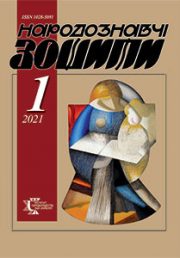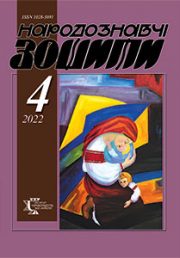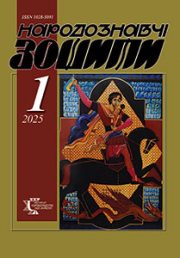The Ethnology Notebooks. 2023. № 4 (172), 1085—1094
UDK 75.021.32-035.676.332.2:061.2(100)-024.14(477)
DOI https://doi.org/10.15407/nz2023.04.1085
PHILOSOPHICAL AND TECHNIQUE — EXPLORING ORIGINS OF CREATIVITY IN WATERCOLORS OF N. KUCHABSKA
ZINCHUK Olga
- ORCID ID: https://orcid.org/0000-0002-4623-6444
- Artist Restorer of the National Research
- and Restoration Centre of Ukraine,
- Lviv Branch,
- 10, Lesi Ukrainky str., 79000, Lviv, Ukraine,
- Contacts: e-mail: Zinchukolga222@gmail.com
Abstract. Introduction. The article outlines the individual characteristics of the watercolor techniques of N. Kuchabska and analyzes their philosophical and semantic content. Special attention is paid to the unique role of the artist in enriching the watercolor technique with her distinct artistic approach, popularizing the chosen technique through being publicly outspoken about her views, teaching, taking part in charity events, and acting as the coordinator of the Lviv branch of the International Watercolor Society IWS Ukraine.
Problem Statement. The topic of the research was determined while preparing a dissertation on «Watercolor in the system of fine arts of Lviv in the second half of the 20th — beginning of the 21st century: typology, functional field, artistic and aesthetic features». The study of the artistic approach, visuals, and philosophical views of the artist N. Kuchabska allows us to enhance and diversify the works of contemporary artists of the Lviv watercolor school.
Purpose. To highlight the worldview, philosophical, and technique-exploring origins of the works of the young generation of watercolorists using the example of the progressive artist N. Kuchabska; to follow the artistic evolution of the Lviv art community and to popularize watercolor.
Methods. The historical method was applied to look into the course of artistic events and activities of the Lviv watercolor community at the beginning of the 21st century. The descriptive method was used to study N. Kuchabska’s original works, her unique style features, and distinct methods of watercolor painting.
Results, Conclusion. To summarize, we may state that the distinct graphic language in the watercolors of N. Kuchabska which was developed through experimental exploration and creative flair, greatly diversifies a wide range of works by representatives of the Lviv watercolor school. N. Kuchabska creates textures and streaks using a special sphere of her own invention as well as specially prepared hand-made granules of watercolor pigments. The colors N. Kuchabska chooses and the technique of light and shadow contrast she often uses help the author interpret landscapes. The bold introduction of colors gives a sense of consistency in watercolor paintings. With her bright and original works, the artist demonstrates her mastery through her interpretation and stylization of landscapes (mountains, fields, rivers) and the elements (water, wind, rain) in Ukraine and far beyond its borders in the art world.
Keywords: Watercolorist N. Kuchabska, artist’s graphic techniques, watercolor granulation, exhibitions, coordinator of the Lviv branch of the International Watercolor Society IWS Ukraine.
Received 18.07.2023
REFERENCES
- (2017). September 19—23rd. International Symposium «Week of Watercolor Mastery in Lviv»: Creation of a joint work of art, size 10 x 1,5 m. Facebook. LVIV Watercolor WEEK Workshop: group page. October 20th. Video clip (11:27 min.). Retrieved from: https://www.facebook.com/water colorweek/videos/videos/371194690001699/ (last accessed: 20.05.2023).
- (2014). Creation of the national branch (Ukraine) of the International Watercolor Society, Ukraine, January 2014. Facebook. IWS Ukraine. January 14. Retrieved from: https://www/facebook.com/groops/IWSUKRAINE/ (last accessed: 20.05.2023).
- (2012). About The International Watercolor Society: Turkey, January 2012. International Watercolor Sociеtу: website. 20 January. Retrieved from: http://iwsglobe.org/index.php/about-us/ (last accessed: 20.05.2023).
- Farthing, S., & Cork, R. (Eds.). (2023). Art: The Whole Story (Pp. 8—9). Kharkiv: Vydavnytstvo Vivat [in Ukrainian].
- Otchych, H., Zaliznyak, O., & Yurchenko, I. (Ed.). (2018). Fabriano’s Ukrainian palette: graphic materials, catalog (Pp. 21—32). Lviv: College of Printing of the Ukrainian Academy of Printing [in Ukrainian].
- Dohan, H., Otchych, H., & Kochetova, Yu. (2021). Exhibition Catalog: International Watercolor Exhibition Tour «Our Wonderful World», Ukraine-Poland. International Watercolor Association of Ukraine (Pp. 2—5). Ukraine; Poland [in Polish].
- (2008). Art map of Ukraine: Painting. Graphics. Sculpture, 1900—2008. Album (Pp. 4—20). Kyiv: Yuvelir Pres [in Ukrainian].
- Bolhov, V. (2020) The Gold Fund of the Nation: A Research. Creativity. Professionalism (Pp. 10—24). Kyiv: Typohrafiya vid A do Ya [in Ukrainian].
- Holubets, O. (2012). Art of the 20th century: the Ukrainian way (Pp. 5—6). Lviv: Kolir Pro [in Ukrainian].
- Holubets, O. (2014). Lviv contemporary painting (Pp. 10—15). Lviv: BaK [in Ukrainian].
- Yatsiv, R. (1992). Lviv graphics 1945—1990. Traditions and innovation (Pp. 2—10). Kyiv: Naukova dumka [in Ukrainian].
- Yatsiv, R. (2006). Ukrainian art of the 20th century: Ideas, phenomena, personalities (Pp. 3—9). Lviv: Afisha [in Ukrainian].
- Horbenko, A., & Kravchenko, H. (Eds.). (2018). Sea of Watercolors. Ukrainian and International Biennale Exhibition (graphic materials) (Pp. 2—10). Organizers and coordinators of the exhibition The National Union of Artists of Ukraine; The National Academy of Visual Arts and Architecture; Odesa Oblast Organization of the National Union of Artists of Ukraine. Drohobych: Kolo [in Ukrainian].
- Zinchuk, O., & Otchych, H. (2021). Activities of the Ukrainian national branch of the International Watercolor Society. Colloquium-journal, 17 (104), 4—13 [in Ukrainian].
- Zinchuk, O. (2017). Stepan Kostyrka: a painter, a teacher. Kharkiv State Academy of Design and Arts. Traditions and innovations in Higher Education in Art and Architecture, 4, 86—89 [in Ukrainian].







